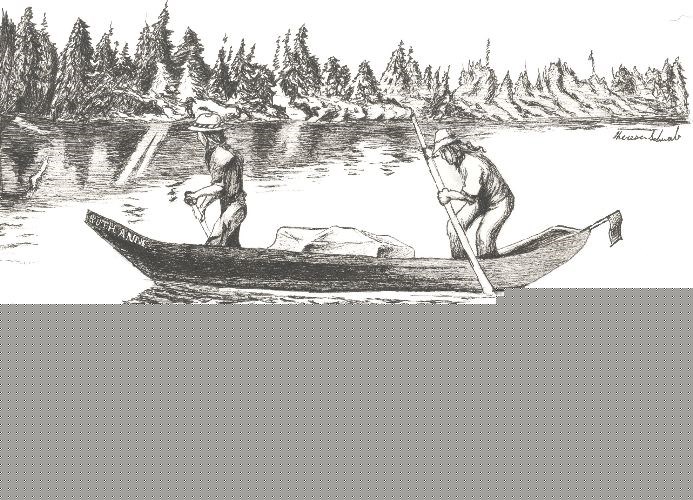Previously, Caribou Joe met Sandbar Sam and learned about a new job opportunity.
"Dynamite You never mentioned dynamite."
"Listen, Joe," explained Sam. "This is important work and we're getting paid generously for the deliveries. We just paddle the canoe and make a few stops along the way."
Joe had signed up for a new job not realizing they would be transporting cases of dynamite down the Fraser River from Mile 53 to Grand Trunk Pacific
construction camps or depots.
Sam, who Joe later nicknamed, Sandbar Sam, was in charge of the transport operation. He was promoted to captain by the foreman, Mr. Bates of the Siems-Carey Company. Joe was designated first mate.
The two friends began their downstream journey on April 26, 1913. For Sam, the dyno-run was a promotion and break from his usual springtime job of running cargo-filled scows down to South Fort George. For Joe the river job proved to be just as dangerous as his
former whiskey smuggling profession.
The long wooden pointer boat assigned to the men had Ruth-Ann painted on her forward hull. She was equipped with two paddles, two wooden poles, camping gear and a red flag on a short mast.
Joe eyed the red piece of cloth with great interest as they prepared to leave the company wharf. The flag was to be displayed at all times to indicate the nature of their cargo.
"Sam, where'd you get this old dugout from? The Indians?" asked Joe.
"You got that right. There's a few of these canoes around. They're made by the Carriers up in Fort George."
The downstream journey would be less strenuous than on the return. The two men would let the current carry them along on most stretches of the river and paddle just enough to keep the boat straight in the water.
Bringing the canoe back up the Fraser River would be labour-intensive and full-time work. Sam and his new partner would be using their 12-foot spruce poles during the return trip.
With outstretched arms and a firm grip on the poles, the pointer boat would be slowly propelled upstream against the strong current. Joe used to say, "We were pushing the bottom out of the river!"
Their stops on the run were designated river-depots shown on the delivery list given to them by Mr. Bates. Horse-drawn wagons would transport the dyno inland, from the drop-off points, to where the railway roadbed was being prepared.
The cargo was packed in wooden boxes, placed in the middle of the canoe, and covered with a large canvas tarp.
The men had been warned about the possible dangers of the dynamite sticks they carried. Joe observed that most of the boats they met on the river steered clear of the Ruth-Ann and her red flag.
In the next episode, Pointer Boat Cruise, Sam and Joe make their deliveries, paddle the canoe and still have time to read the newspaper.



